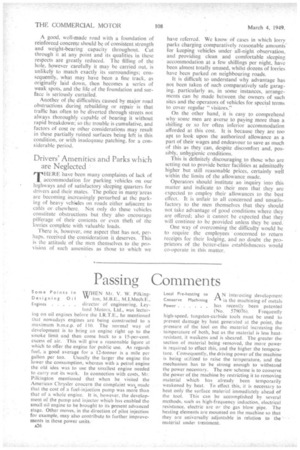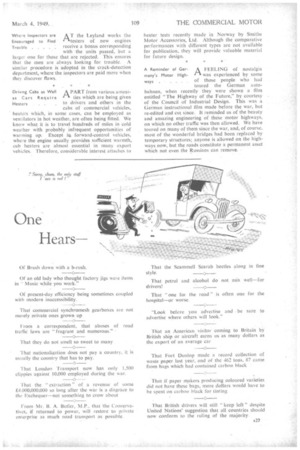Passing Comments
Page 2

Page 3

If you've noticed an error in this article please click here to report it so we can fix it.
Some Points in WHEN Mr. V. W. Pilking Designing Oil " ton, M.B.E., M.I.Mech.E., Engines director of engineering, Ley land Motors, Ltd., was lecturing on oil engines before the I.R.T.E., he mentioned that nowadays engines are being constructed to a maximum b.m.e.p. of 110. The normal way of development is to bring an engine right up to the smoke limit and then come back to a 15-per-cent. excess of air. This will give a reasonable ligure at which to offer the engine for public use. As regards fuel, a good average for a 12-tonner is a mile per gallon per ton. Usually the larger the engine the lower the consumption, whereas with a petrol engine the old idea was to use the smallest engine needed to carry out its work. In connection with costs, Mr: Pilkington mentioned that when he visited the American Chrysler concern the complaint was. made that the cost of a fuel-injection pump was more than that of a whole engine. It is, however, the development of the pump and injector which has enabled the small oil engine to be brought to its present advanced stage. Other moves, in the direction of pilot injection for example, may also contribute to further improvements in these power units.. Local Pre-heating to AN interesting development Conserve Machining in the machining of metals Power . . , . has recently been patented (No. 579076). Frequently high-speed; tungsten-carbide tools must be used to prevent damage by heat generated at the point, the pressure of the tool on the material increasing the temperature of both, but as the material is less heatresistant, it weakens and is sheared. The greater the section of material being removed, the more power is required to effect this, and the higher the temperature. Consequently, the driving power of the machine is being utilized to raise the temperature, and the mechanism has to be strong enough to withstand the power necessary. The new scheme is to conserve the power of the machine by restricting it to removing material which has already been temporarily weakened by heat. To effect this, it is necessary to heat only the surface material immediately ahead of the tool. This can be accomplished by several methods, such as high-frequency induction, electrical resistance, electric arc or the gas blow pipe. The heating elements are mounted on the machine so that they are universally adjustable in relation to the 'material under treatment. AT the Leyland works the testers of new engines. receive a bonus corresponding with the units passed, but a larger one for those that are rejected. This ensures that the men are always looking for trouble. A similar procedure is adopted in the crack-detection department, where the inspectors are paid more when they discover flaws. Where Inspectors are Encouraged to Find
Trouble
APART from various ameni
ties which are being given to drivers and others in the cabs of commercial vehicles, heaters which, in some cases, can be employed as ventilators in hot weather, are often being fitted. We know what it is to travel hundreds of miles in cold weather with probably infrequent opportunities of warming up. Except i. forward-control vehicles, where the engine usually provides sufficient warmth, cab heaters are almost essential in many export vehicles. Therefore, considerable interest attaches to
Heaters . . .
heater tests recently made in Norway by Smiths Motor Accessories, Ltd. Although the comparative performances with different types are not available for publication, they will provide valuable material for future design..
A Reminder of GerA FEELING of nostalgia many's Motor High1-1. was experienced by some
ways . . . of those people who had toured the German autobahnen, when recently they were shown a film entitled "The Highway of the Future," by courtesy of the Council of Industrial Design. This was a German instructional film made before the war, but re-edited and cut since. It reminded us of the beauty and amazing engineering of .these motor highways, on which no other traffic was then allowed. We have toured on many of them since the war, and, of course, most of the wonderful bridges had been replaced by temporary structures; anyone is allowed on the highways now, but the roads constitute a permanent asset which not even the Russians can remove. •


























